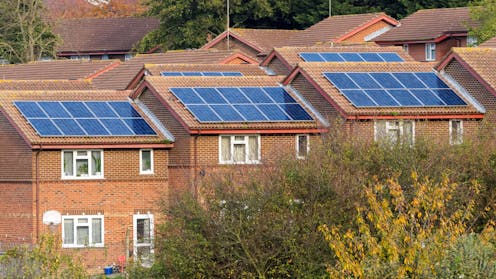Zonal pricing is dead – here’s how the UK should change its electricity system instead
Marcin Rogozinski/Shutterstock
The UK government has decided against setting different prices for electricity based on the locations of consumers.
Zonal pricing would have categorised Britain into distinct zones, each with wholesale electricity prices that reflect how much power is generated locally, and how much demand there is for it. It would have raised prices in areas with lots of demand but low generation, like London, and lowered them where supply outstrips demand, such as in the turbine-rich Scottish Highlands.
This might have caused an immediate increase in the energy bills of already vulnerable households in some high-demand, low-generation areas, such as Tower Hamlets in London and Blackpool in north-west England.
But the idea was to encourage the construction of renewable energy to meet high demand in higher-priced zones, and prompt big electricity consumers to move to where electricity is cheaper. It was also intended to ease the need for new infrastructure to transmit electricity over long distances, like pylons. Australia, Norway and several EU nations already use this method.
The ultimate goal of zonal pricing was to make the price of electricity more accurately reflect generation and transmission costs. However, one thing has significantly inflated electricity prices in recent years, which this pricing method wouldn’t have addressed on its own: gas.
Get your news from actual experts, straight to your inbox. Sign up to our daily newsletter to receive all The Conversation UK’s latest coverage of news and research, from politics and business to the arts and sciences.
Gas is expensive, even more so since Russia’s invasion of Ukraine. Britain’s electricity system operator brings power plants onto the system to meet demand in order of the lowest to highest marginal costs.
The point at which supply meets demand forms the wholesale price of electricity. Renewable sources, like wind and solar, have zero or very low marginal costs. But most of the time the wholesale price is set by gas plants, because they can readily fill a gap in supply but have high and erratic marginal costs (largely tied to what they pay for fuel).
We need another, cheaper technology to set the wholesale price of electricity. Batteries, which can store electricity over several hours, and options capable of storing energy for longer, such as compressed air and low-carbon hydrogen, could be just the thing.
The idea is simple: batteries can be charged at times when there is a lot of surplus electricity generation (on a bright, windy day, for example) and discharge it at times of peak demand (or when the sun doesn’t shine and the wind doesn’t blow). This would entail grid operators (and ultimately, consumers) not having to pay gas plants to fire up when renewable generation cannot meet the shortfall.
Unfortunately, batteries comprised just 6% of Britain’s total electricity capacity in 2024. Investment in energy storage has lagged behind what the government forecasts is necessary to meet its 2030 clean power goals, but it is at least increasing.
Research shows that the more money that is invested in batteries, the more associated costs come down. If used instead of gas to stabilise the grid, energy storage could significantly lower the wholesale cost of the UK’s energy over time, and with the right balance of policies, household bills too. This would require subsidies to cover some of the cost of making and installing batteries, and planning mandates to build new renewables alongside new batteries.
Affordable and fair
The government could also try alternatives to zonal pricing. Wholesale electricity prices could reflect the “strike” price in renewable energy contracts. This is the price at which developers have agreed to build clean electricity generation projects, like wind farms. This would mean that gas no longer sets the wholesale price, but stable, predictable prices agreed years in advance, which would help to regulate the retail costs consumers pay.
Solar arrays installed on farmland in Devon, southern England.
Pjhpix/Shutterstock
These types of reforms can help set efficient energy prices, which the government usually talks about as the price needed to encourage investment in new energy technologies. But just because prices are efficient, it doesn’t mean they’re fair. Some households struggle to afford their energy bills even when markets are working efficiently. So, when prices change to encourage cleaner energy, it can hit them harder.
The government should implement new policies and expand eligibility for existing measures to take the burden off energy-poor households. These include social tariffs, which offer discounted rates to vulnerable consumers, and discounts for blocks of electricity use when renewables are generating a lot of it.
Transition funds could help poorer households meet bills, while schemes to encourage home insulation and other improvements could see more homes with rooftop solar panels and battery storage.
This support, combined with increasing investment in energy storage and renewables, will lower the wholesale price of electricity over time – and make energy more affordable (and fair) for everyone.
Don’t have time to read about climate change as much as you’d like?
Get a weekly roundup in your inbox instead. Every Wednesday, The Conversation’s environment editor writes Imagine, a short email that goes a little deeper into just one climate issue. Join the 45,000+ readers who’ve subscribed so far.
Anupama Sen has previously received funding from the Quadrature Climate Foundation and Children’s Investment Fund Foundation.
Cassandra Etter-Wenzel and Sam Fankhauser do not work for, consult, own shares in or receive funding from any company or organisation that would benefit from this article, and have disclosed no relevant affiliations beyond their academic appointment.



